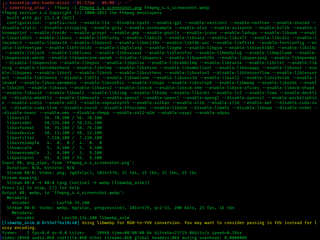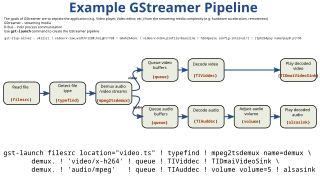
Crystal HD is Broadcom's hardware semiconductor intellectual property (SIP) core that performs video decoding. [1]

Crystal HD is Broadcom's hardware semiconductor intellectual property (SIP) core that performs video decoding. [1]
Crystal HD includes single chip high-definition advanced media processors BCM70012 (codenamed Link) and BCM70015 (codenamed Flea); [2] these chips are available on mini PCIe cards. [3] [4]
The BCM970012 supports hardware decoding of H.264/MPEG-4 AVC, VC-1, WMV9 and MPEG-2 and the BCM970015 additionally supports DivX 3.11, 4.1, 5.X, 6.X and Xvid. [3] VP8, VP9, Daala and HEVC are not supported.
Crystal HD is found in Intel Atom based machines, [5] such as the Dell Inspiron Mini 10 [6] HP Slate 500 or ExoPC, ASUS Eee Keyboard.[ citation needed ]
The commercial relevancy of dedicated video decoding accelerators was ended by the launch of the Intel Core i-series, featuring an integrated GPU with hardware video decoding (formerly only widespreadly available in discrete GPUs).
The Crystal HD SIP core must be supported by a device driver, which provides the video interfaces. One of these interfaces is then used by end-user software, for example Media Player Classic or GStreamer, to access CrystalHD.
Broadcom published a Linux device driver under GNU General Public License (GPL) version 2. [7] Broadcom also published application and library source code on a royalty-free basis under the GNU Lesser General Public License (LGPL), version 2.1
Crystal HD can be accessed through the Video Acceleration API interface via an experimental driver (however, it cannot be recovered from the linked archive). [8] [ unreliable source? ] A GStreamer plugin is available. [9]
Crystal HD support is available in FFmpeg and MPlayer when compiled with the corresponding option. [10] [11]
It could be added to first generation Apple TV when OSMC is installed, [12] although support was dropped in 2017. [13]
Broadcom published a device driver for Microsoft Windows that provides accelerated DirectShow renderers filters. [7]

MPlayer is a free and open-source media player software application. It is available for Linux, OS X and Microsoft Windows. Versions for OS/2, Syllable, AmigaOS, MorphOS and AROS Research Operating System are also available. A port for DOS using DJGPP is also available. Versions for the Wii Homebrew Channel and Amazon Kindle have also been developed.

FFmpeg is a free and open-source software project consisting of a suite of libraries and programs for handling video, audio, and other multimedia files and streams. At its core is the command-line ffmpeg tool itself, designed for processing video and audio files. It is widely used for format transcoding, basic editing, video scaling, video post-production effects, and standards compliance.

A graphics processing unit (GPU) is a specialized electronic circuit initially designed for digital image processing and to accelerate computer graphics, being present either as a discrete video card or embedded on motherboards, mobile phones, personal computers, workstations, and game consoles. After their initial design, GPUs were found to be useful for non-graphic calculations involving embarrassingly parallel problems due to their parallel structure. Other non-graphical uses include the training of neural networks and cryptocurrency mining.

GStreamer is a pipeline-based multimedia framework that links together a wide variety of media processing systems to complete complex workflows. For instance, GStreamer can be used to build a system that reads files in one format, processes them, and exports them in another. The formats and processes can be changed in a plug and play fashion.

Kodi is a free and open-source media player and technology convergence software application developed by the Kodi Foundation, a non-profit technology consortium. Kodi is available for multiple operating systems and hardware platforms, with a software 10-foot user interface for use with televisions and remote controls. It allows users to play and view most streaming media, such as videos, music, podcasts, and videos from the Internet, as well as all common digital media files from local and network storage media, or TV gateway viewer.

A free and open-source graphics device driver is a software stack which controls computer-graphics hardware and supports graphics-rendering application programming interfaces (APIs) and is released under a free and open-source software license. Graphics device drivers are written for specific hardware to work within a specific operating system kernel and to support a range of APIs used by applications to access the graphics hardware. They may also control output to the display if the display driver is part of the graphics hardware. Most free and open-source graphics device drivers are developed by the Mesa project. The driver is made up of a compiler, a rendering API, and software which manages access to the graphics hardware.
X-Video Motion Compensation (XvMC), is an extension of the X video extension (Xv) for the X Window System. The XvMC API allows video programs to offload portions of the video decoding process to the GPU video-hardware. In theory this process should also reduce bus bandwidth requirements. Currently, the supported portions to be offloaded by XvMC onto the GPU are motion compensation and inverse discrete cosine transform (iDCT) for MPEG-2 video. XvMC also supports offloading decoding of mo comp, iDCT, and VLD for not only MPEG-2 but also MPEG-4 ASP video on VIA Unichrome hardware.
Unified Video Decoder is the name given to AMD's dedicated video decoding ASIC. There are multiple versions implementing a multitude of video codecs, such as H.264 and VC-1.
The following is a list of H.264/MPEG-4 AVC products and implementations.
PureVideo is Nvidia's hardware SIP core that performs video decoding. PureVideo is integrated into some of the Nvidia GPUs, and it supports hardware decoding of multiple video codec standards: MPEG-2, VC-1, H.264, HEVC, and AV1. PureVideo occupies a considerable amount of a GPU's die area and should not be confused with Nvidia NVENC. In addition to video decoding on chip, PureVideo offers features such as edge enhancement, noise reduction, deinterlacing, dynamic contrast enhancement and color enhancement.
Video Acceleration API (VA-API) is an open source application programming interface that allows applications such as VLC media player or GStreamer to use hardware video acceleration capabilities, usually provided by the graphics processing unit (GPU). It is implemented by the free and open-source library libva, combined with a hardware-specific driver, usually provided together with the GPU driver.

VideoCore is a series of low-power mobile multimedia processors originally developed by Alphamosaic Ltd and now owned by Broadcom. Alphamosaic marketed its first version as a two-dimensional DSP architecture that makes it flexible and efficient enough to decode a number of multimedia codecs in software while maintaining low power usage. The semiconductor intellectual property core has been found so far only on Broadcom SoCs.
X-Video Bitstream Acceleration (XvBA), designed by AMD Graphics for its Radeon GPU and APU, is an arbitrary extension of the X video extension (Xv) for the X Window System on Linux operating-systems. XvBA API allows video programs to offload portions of the video decoding process to the GPU video-hardware. Currently, the portions designed to be offloaded by XvBA onto the GPU are currently motion compensation (MC) and inverse discrete cosine transform (IDCT), and variable-length decoding (VLD) for MPEG-2, MPEG-4 ASP, MPEG-4 AVC (H.264), WMV3, and VC-1 encoded video.
Video Decode and Presentation API for Unix (VDPAU) is a royalty-free application programming interface (API) as well as its implementation as free and open-source library distributed under the MIT License. VDPAU is also supported by Nvidia.
Intel Quick Sync Video is Intel's brand for its dedicated video encoding and decoding hardware core. Quick Sync was introduced with the Sandy Bridge CPU microarchitecture on 9 January 2011 and has been found on the die of Intel CPUs ever since.
Video Code Engine is AMD's video encoding application-specific integrated circuit implementing the video codec H.264/MPEG-4 AVC. Since 2012 it was integrated into all of their GPUs and APUs except Oland.
High Efficiency Video Coding implementations and products covers the implementations and products of High Efficiency Video Coding (HEVC).
Nvidia NVENC is a feature in Nvidia graphics cards that performs video encoding, offloading this compute-intensive task from the CPU to a dedicated part of the GPU. It was introduced with the Kepler-based GeForce 600 series in March 2012.
Nvidia NVDEC is a feature in its graphics cards that performs video decoding, offloading this compute-intensive task from the CPU. NVDEC is a successor of PureVideo and is available in Kepler and later NVIDIA GPUs.
Video Core Next is AMD's brand for its dedicated video encoding and decoding hardware core. It is a family of hardware accelerator designs for encoding and decoding video, and is built into AMD's GPUs and APUs since AMD Raven Ridge, released January 2018.